GARDENS BY THE BAY

PINK PERENNIALS & THEIR COMPANIONS - 1
The colour pink comes in many forms, many quite descriptive. There are fruity shades such as cerise, strawberry and raspberry. There are salmon pinks. There are degrees of pink from pale to deep. Shades may be soft, clear, bright or brilliant - they may be warm or hot. They can be rose or dusty rose, lavender-pink or lilac-pink. Some are even metallic pink, shell pink or ice pink.
Most shades of pink are complemented by purples, grays and whites. Choosing yellow companions is a trickier prospect. There is many a "marriage made in heaven" to be found among the partnerships below.
* Watch for the animated hummingbird and butterfly with the plants that attract them. *
The deer icon indicates plants that deer are not usually attracted to.
   The best time and method to propagate plants can be found on our image-intensive PROPAGATION page.
To help your plants grow their best, check out our FERTILIZATION page.
To create your own plant partnerships based on tried and true color theory, check out our GARDEN COLOR page.
To see if a particular plant is on this page press Ctrl+F, type in the name, then click the Find button.
The best time and method to propagate plants can be found on our image-intensive PROPAGATION page.
To help your plants grow their best, check out our FERTILIZATION page.
To create your own plant partnerships based on tried and true color theory, check out our GARDEN COLOR page.
To see if a particular plant is on this page press Ctrl+F, type in the name, then click the Find button.
ACHILLEA
 This genus was named for the mythic Greek warrior, Achilles, alleged to have soothed his soldiers' wounds with the crushed leaves of the Yarrow plant.
Achillea: dark pink forms
This genus was named for the mythic Greek warrior, Achilles, alleged to have soothed his soldiers' wounds with the crushed leaves of the Yarrow plant.
Achillea: dark pink forms
in front of: Veronica (tall blue) & white daisies
Achillea millefolium: Common Yarrow, mostly pink and red shades
with: Valeriana officinalis, Digitalis
Achillea millefolium 'Cerise Queen': 'Cerise Queen' pink Yarrow, a rapid spreader
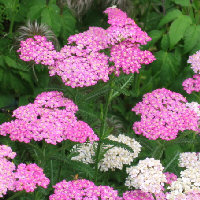
note: this cultivar progresses through various bright to pale pink shades as the blooms age for a lovely effect
with: Linum perenne, Chrysanthemum x superbum, Salvia x superba, Valeriana, Digitalis
Achillea 'Salmon Beauty': salmon-pink underlaid with pale yellow
with: Delphinium (light blue)
behind edging of: Veronica 'Goodness Grows' or Stachys 'Silver Carpet'
combined with: Chrysanthemum x superbum (double) & Hemerocallis (dark red)
combined with: Veronica longifolia & Gypsophila 'Rosy Veil'
Yarrows come in many colours. Follow the links to find choices you might want to add to your gardens, as well as the plants that complement them best.
orange Yarrows
red Yarrows
silver foliage Yarrows
white Yarrows
yellow Yarrows
ALCEA
 To start Hollyhocks from seed, sow directly where you want plants to grow. Do so in fall in rich, moist, well-drained soil. Save seed from your favourites but pull out older plants after bloom. Rust disease affects older plants worse than it does younger ones. Never compost any part of this biennial.
Alcea rosea 'Chater's Double': Chater's Double Hollyhock, pink
To start Hollyhocks from seed, sow directly where you want plants to grow. Do so in fall in rich, moist, well-drained soil. Save seed from your favourites but pull out older plants after bloom. Rust disease affects older plants worse than it does younger ones. Never compost any part of this biennial.
Alcea rosea 'Chater's Double': Chater's Double Hollyhock, pink
behind: Baptisia australis, Paeonia, Dictamnus, Aconitum, 3' yellow Achillea
near: Gypsophila paniculata, Alcea (tall white forms)
For Hollyhocks of various colours, follow the links below.
orange Hollyhocks
red Hollyhocks
white Hollyhocks
yellow Hollyhocks
Hollyhocks to attract Hummingbirds
If you've given up on Hollyhocks entirely, preferring something somewhat shorter or less disease-prone, you might want to try either of the pink-flowered look-alikes below.
Malva
Sidalcea
ANEMONE
 Many of the pink Windflowers are among the fall-blooming forms, as you will see below. There are also pink shades in the spring-bloomers as well.
Anemone hupehensis 'September Charm': Chinese Anemone, rose-coloured flowers
Many of the pink Windflowers are among the fall-blooming forms, as you will see below. There are also pink shades in the spring-bloomers as well.
Anemone hupehensis 'September Charm': Chinese Anemone, rose-coloured flowers

where: in masses against a south-facing stone wall
in front of: shrubs, evergreens
with: Aconitum, Cimicifuga simplex, Aster, Solidago, Helianthus, Ornamental Grasses, ferns
with: Epimedium, Hosta, Salvia
Anemone x hybrida 'Lady Gilmour': medium pink, semi-double, flowers to 3" across
synonym: 'Crispa' after the crisped green leaves, like curly parsley
Anemone x hybrida 'Pamina': Double Japanese Anemone, deep pink double flowers on 3-5' stems
Anemone japonica: pink
with: blue New England or New York Aster & Aster x frikartii (blue forms)
Anemone japonica 'Margarete': semi-double deep pink
with: blue New England or New York Aster & Aster x frikartii (blue forms)
Anemone tomentosa 'Robustissima': Japanese Anemone, metallic-pink flowers
with: long-legged perennials
behind: Alchemilla mollis
combined with: Cimicifuga, Thalictrum & Veronicastrum
combined with: Dahlia 'Park Princess', Galtonia candicans & Veronica 'Blue Peter'
To see what perennials complement other shades of Anemone, follow the links below.
blue Anemone
Anemone for shade
white Anemone
ANTENNARIA
 A member of the Compositae family, Cat's Ears is a genus of evergreen to semi-evergreen ground-covering perennials with mat-like, woolly leaves and fluffy flowers. Blooming in late spring to early summer they are perfect for full sun and well-drained soil.
Antennaria dioica rubra: Pink Pussytoes
For ideas and information, click on the link below.
Pussytoes galore
A member of the Compositae family, Cat's Ears is a genus of evergreen to semi-evergreen ground-covering perennials with mat-like, woolly leaves and fluffy flowers. Blooming in late spring to early summer they are perfect for full sun and well-drained soil.
Antennaria dioica rubra: Pink Pussytoes
For ideas and information, click on the link below.
Pussytoes galore
AQUILEGIA
 The word "graceful" describes this short-lived perennial perfectly. Start only the species from seed sown in autumn or spring. Cultivars will rarely come "true" i.e. resemble the parent plant.
Aquilegia 'Robin': Songbird Strain Columbine
The word "graceful" describes this short-lived perennial perfectly. Start only the species from seed sown in autumn or spring. Cultivars will rarely come "true" i.e. resemble the parent plant.
Aquilegia 'Robin': Songbird Strain Columbine
with: blue and purple shades of Iris sibirica
combined with: Heuchera 'June Bride' & Geranium x 'Johnson's Blue'
There is more information as well as Columbines of many other colours and colour combinations to access with the following links.
red Columbines
Columbines for shade
white Columbines
Columbines to attract Hummingbirds
ARABIS
 Early autumn is the time to sow fresh seeds or plant root divisions of this spring-blooming rock garden or border edging perennial. Gritty, well-drained soil in full sun is best.
Arabis caucasica 'Compinkie': rosy-pink
Arabis caucasica 'Spring Charm': pink Wall Cress
Arabis comes in other colours as well.
more Arabis forms for edging
white Arabis forms
Arabis with variegated foliage
Early autumn is the time to sow fresh seeds or plant root divisions of this spring-blooming rock garden or border edging perennial. Gritty, well-drained soil in full sun is best.
Arabis caucasica 'Compinkie': rosy-pink
Arabis caucasica 'Spring Charm': pink Wall Cress
Arabis comes in other colours as well.
more Arabis forms for edging
white Arabis forms
Arabis with variegated foliage
ARMERIA
To start this grassy-leaved perennial from seed, sow in early spring. Propagation by division can be done in either early spring or fall. Gritty, well-drained soil in full sun will ensure best performance.
Armeria maritima: Common Thrift
Armeria maritima 'Dusseldorfer Pride'
As far as I know, Thrift comes in only two colours - white and pink. For more information and companionships follow the link below.
Thrift as edgers
ASTER
 Did you know that the sprays of Asters look wonderful in both fresh and dried arrangements? The small, daisy-like blooms usually have bright yellow centres. Seeds sown in spring will bloom the following year. Remember to divide clumps every 2-3 years to keep them vigorous. Replant only the healthy outer portions and discard the spent centre.
Aster 'Crimson Brocade': tall pink
Did you know that the sprays of Asters look wonderful in both fresh and dried arrangements? The small, daisy-like blooms usually have bright yellow centres. Seeds sown in spring will bloom the following year. Remember to divide clumps every 2-3 years to keep them vigorous. Replant only the healthy outer portions and discard the spent centre.
Aster 'Crimson Brocade': tall pink
with: Cimicifuga simplex 'White Pearl'
Aster novae-angliae 'Alma Potschke': deep salmon-pink
Aster novi-belgii 'Kassel': pink Michaelmas Daisy
Aster is a huge genus with flowers in a multitude of colours. Try any of those below in your gardens soon. And read the additional information on each of the pages to help you grow them to best advantage.
Asters that attract butterflies
blue-flowered Asters
purple Asters
Asters for shade
white Asters
ASTILBE
 The blooming spikes of Astilbe in their myriad colours also make wonderful cut flowers for arrangements, either fresh or dried. The name Astilbe, according to The American Horticultural Society's FLOWER FINDER means "without color" and refers to the leaves. Here is another interesting tidbit from the same source... If your Astilbe's leaves are shiny, it most likely belongs to the species Astilbe simplicifolia.
Astilbe chinensis 'Pumila'
Add some of the Astilbe forms below to your plant shopping list. Check out each page so you'll have all the information you need to keep yours performing at their peak.
Astilbe forms for edging
Astilbe forms for shade
white Astilbe forms
The blooming spikes of Astilbe in their myriad colours also make wonderful cut flowers for arrangements, either fresh or dried. The name Astilbe, according to The American Horticultural Society's FLOWER FINDER means "without color" and refers to the leaves. Here is another interesting tidbit from the same source... If your Astilbe's leaves are shiny, it most likely belongs to the species Astilbe simplicifolia.
Astilbe chinensis 'Pumila'
Add some of the Astilbe forms below to your plant shopping list. Check out each page so you'll have all the information you need to keep yours performing at their peak.
Astilbe forms for edging
Astilbe forms for shade
white Astilbe forms
BEGONIA
The Hardy Begonia is said to be hardy only to Zone 6 but would perhaps be worth a try with some winter protection in Zone 5. Both flowers and foliage are attractive. Growing from a small bulb-like tuber, it reaches a height of 2 feet.
Begonia grandis
If you thought Begonia was a genus of only annuals, check out the link below for a perennial form.
hardy Begonia for shade
BELLIS
This genus, grown in full sun to semi-shade, in fertile, well-drained soil, will perform as a perennial or biennial. Dead-head the tiny, daisy-like flowers after bloom. Seed should be sown in early summer. Division should be done after the flowering period is over. Moisture needs to be maintained through the growing period.
Bellis perennis: a biennial
under: red and pink Tulipa, Narcissus & Tulipa
BERGENIA
 "Vigorous" is a word often used to describe Pig Squeak, also known as Heartleaf Bergenia, a perennial that grows best in moist, well-drained soil with lots of organic matter. Propagate by seed or root division in early spring. Enjoy both its large, shiny, heart-shaped leaves and its mid-spring blooms.
Bergenia cordifolia
"Vigorous" is a word often used to describe Pig Squeak, also known as Heartleaf Bergenia, a perennial that grows best in moist, well-drained soil with lots of organic matter. Propagate by seed or root division in early spring. Enjoy both its large, shiny, heart-shaped leaves and its mid-spring blooms.
Bergenia cordifolia
soil preference: moist, humus-rich but tolerates dry shade under trees
where: in full sun (in the north) to light shade
use for: rock walls, stone walks, in front of shrubs, as accent at base of stone wall, along paths
with: fine-textured shrubs or perennials, plants with straplike leaves
with: Hosta, ground covers
behind: ferns, other delicate woodland plants
shape contrast in front of: arching Hemerocallis, spikes of Digitalis
with: Polygonatum spp, Pulmonaria spp, Dicentra, Yucca, Helleborus
combined with: bold Bergenia with lacy Paeonia & spiky Iris sibirica
Bergenia cordifolia: pink forms

beside: Arabis (double-flowered)
in front of: Tulipa (Triumph type - plum, mauve or lavender)
beside: Lamium 'Pink Pewter' (silvery leaves & rose-pink flowers) - "the prettiest dead nettle there is": Patrick Lima
To bring a little light into shaded areas try the link below.
white Bergenia
BOLTONIA
 An airy perennial that blooms in late summer to early fall is a welcome addition to the rear of a garden. This American native has masses of small flowers with ray petals and rounded yellow centres. Divide every 2 years in spring and replant with some sun in well-drained, humusy soil.
Boltonia asteroides 'Pink Beauty': pink Boltonia
An airy perennial that blooms in late summer to early fall is a welcome addition to the rear of a garden. This American native has masses of small flowers with ray petals and rounded yellow centres. Divide every 2 years in spring and replant with some sun in well-drained, humusy soil.
Boltonia asteroides 'Pink Beauty': pink Boltonia
with: Physostegia virginiana, Eupatorium purpureum, Papaver orientale, Boltonia asteroides 'Snowbank'
with: Aster 'Alma Potschke'
with: a white-variegated cultivar of Japanese silver grass, Miscanthus sinensis
with: Buddleia x 'Lochinch' (hybrid with B. fallowiana)
If you prefer white to pink try the link below.
white Boltonia
CAMPANULA
 Pink may not be the colour you think of first when Bellflower is mentioned. But there are pink choices for bloom in late spring or early summer, sometimes into fall depending on species. You might also want to try Bellflower look-alikes including Platycodon - Balloon Flower and Adenophora - Lady-Bells.
Campanula lactiflora 'Loddon Anna': soft pink
Pink may not be the colour you think of first when Bellflower is mentioned. But there are pink choices for bloom in late spring or early summer, sometimes into fall depending on species. You might also want to try Bellflower look-alikes including Platycodon - Balloon Flower and Adenophora - Lady-Bells.
Campanula lactiflora 'Loddon Anna': soft pink

combined with: white Phlox paniculata, Perovskia atriplicifolia, Caryopteris or Adenophora confusa
Wonderful Bellflowers and their companions are available at the links below.
blue Bellflowers
purple Bellflowers
white Bellflowers
CENTAUREA
 Blooming in spring or summer, Knapweeds are valuable "fillers" in gardens with full sun and well-drained soil. Sow seeds either in spring or early fall where you want plants to grow. Division should be done in spring or fall every 2-3 years.
Centaurea: Perennial Cornflower
Blooming in spring or summer, Knapweeds are valuable "fillers" in gardens with full sun and well-drained soil. Sow seeds either in spring or early fall where you want plants to grow. Division should be done in spring or fall every 2-3 years.
Centaurea: Perennial Cornflower
with early-summer-blooming perennials: Paeonia
Centaurea dealbata: Knapweed, rosy-purple
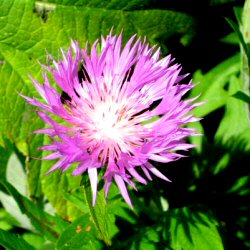
where: meadow plantings, informal gardens
with: Rudbeckia, Achillea, Ornamental Grasses
Centaurea dealbata rosea
beside: Sedum spectabile 'Autumn Joy'
Centaurea hypoleuca 'John Coutts': Knapweed, fluffy deep mauve with white centers
named by: Graham Stuart Thomas after the late Curator of Kew Gardens, London, England
where: massed in mid-bed or at front
beside: Baptisia australis, Cosmos bipinnatus 'Purity'
The different species of Knapweed are quite distinct in their flowers as you will see by following the links below.
blue Knapweed
silver foliage Knapweed
yellow Knapweed
CENTRANTHUS
Well-drained, alkaline soil and full sun are best for this easy to grow genus commonly called Fox's-brush and Jupiter's Beard. Flowers are fragrant and bloom from an early summer start over a long period of time. Apparently dead-heading may encourage late re-blooming. Divide every 2 years in spring or fall.
Centranthus ruber: Red Valerian, rosywhere: with softer-coloured or creamy yellow flowers, in wall or rock gardens
with: Gaura lindheimeri, Verbascum phoeniceum 'Flush of White'
with: Achillea, Aster including A. novi-belgii 'Benary's Composition Mix', Coreopsis
combined with: Nepeta x faassenii, Centranthus ruber 'Snowcloud' & Centaurea montana
combination of: Centranthus 'Coccineus' & Centranthus 'Albiflorus' together
behind: Sedum spectabile 'Stardust', Eryngium bourgatii
Centranthus ruber 'Roseus':
sometimes called: Centranthus ruber var. roseus
surround with: green-leaved plants
not with: other pinks
with: Achillea x 'Moonshine'
CHELONE
  These tall plants for shady, moist sites are known as Turtlehead, Snakehead, Balmony and Pink Turtlehead. They prefer a somewhat acidic soil, with a pH level from 4-6. A late-summer bloom time is also a welcome quality as so many shade-lovers bloom much earlier in the season. Hooded flowers occur in spikes on upright, leafy stems. Maintain constant moisture to ensure survival.
Chelone lyonii: Pink Turtlehead
These tall plants for shady, moist sites are known as Turtlehead, Snakehead, Balmony and Pink Turtlehead. They prefer a somewhat acidic soil, with a pH level from 4-6. A late-summer bloom time is also a welcome quality as so many shade-lovers bloom much earlier in the season. Hooded flowers occur in spikes on upright, leafy stems. Maintain constant moisture to ensure survival.
Chelone lyonii: Pink Turtlehead
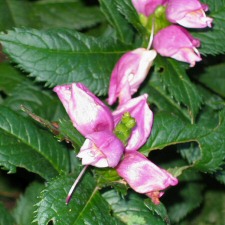
with late-summer bloomers: Aster, Phlox paniculata, Solidago
Chelone obliqua: Pink Turtlehead, rose-pink
in border with: Eupatorium purpureum, Aster, Anaphalis, Anemone x hybrida
in meadow with: Solidago, Helianthus, Ornamental Grasses
at pond edge with: water Iris spp., Lobelia siphilitica, ferns
CHRYSANTHEMUM
Pink Chrysanthemums are numerous. What we term its "flower" is actually comprised of numerous small flowers or florets. They will bloom magnificently in full sun and somewhat fertile, well-drained soil. Division should be done in early spring or after flowering is finished.
Chrysanthemum coccineum: Pyrethrum, Painted Daisy

now called: Tanacetum coccineum
where: at or near front edge of a wide border, no further back than mid-border with lots of room around
behind: Nepeta faassenii
with: Veronica teucrium 'Shirley Blue' (clear azure-blue)
with summer perennials: Achillea, Hemerocallis, Iris, Papaver
combined with: blue Iris sibirica, Thalictrum aquilegiafolium & Paeonia
 Chrysanthemum x rubellum 'Clara Curtis': deep pink singles Chrysanthemum x rubellum 'Clara Curtis': deep pink singles
now called: Dendranthema zawadskii 'Clara Curtis'
combined with: Artemisia ludoviciana 'Silver King' & Aster x frikartii
with: Artemisia 'Powis Castle'
Do you want perennial Chrysanthemums in other colours? Follow the links below for ideas and to learn about reclassification of many types.
red Chrysanthemum forms
white Chrysanthemum forms
a Chrysanthemum form with variegated foliage
COREOPSIS
 Pink Coreopsis? Yes! Pink Tickseed is similar in appearance to Coreopsis verticillata 'Moonbeam'. At 2 feet tall and with blooms from June to September it makes a wonderful edger. My Heritage Perennials PERENNIAL GARDENING GUIDE warns that "Plants are vigorous and spreading, to be used with caution in the border".
Coreopsis rosea: rose-pink Tickseed, Pink Coreopsis
Pink Coreopsis? Yes! Pink Tickseed is similar in appearance to Coreopsis verticillata 'Moonbeam'. At 2 feet tall and with blooms from June to September it makes a wonderful edger. My Heritage Perennials PERENNIAL GARDENING GUIDE warns that "Plants are vigorous and spreading, to be used with caution in the border".
Coreopsis rosea: rose-pink Tickseed, Pink Coreopsis
with: Artemisia 'Silver Brocade'
near: Rudbeckia purpurea
groundcover with: Lilium (when grown near border front)
For different effects in the garden, try the forms that follow. And read the information included to help you grow them well.
Coreopsis as edgers
orange Coreopsis
yellow Coreopsis
DIANTHUS
 All but the alpine forms of Pinks need division every 2 years to ensure vigour. Check out the plant tables at garden nurseries while these beauties are in bloom to see which ones you absolutely must add to your gardens. There will be many.
Dianthus: pink forms
There are many other colour forms and uses for Dianthus. Follow the links below for additional information about growing Pinks, and wonderful companionship ideas to try.
All but the alpine forms of Pinks need division every 2 years to ensure vigour. Check out the plant tables at garden nurseries while these beauties are in bloom to see which ones you absolutely must add to your gardens. There will be many.
Dianthus: pink forms
There are many other colour forms and uses for Dianthus. Follow the links below for additional information about growing Pinks, and wonderful companionship ideas to try.
edging Dianthus
red Dianthus
silver foliage Dianthus
white Dianthus
yellow Dianthus
DICENTRA
Pendent flowers are the hallmark of the Bleeding Hearts. Give them semi-shade and humus-rich, moist, well-drained soil. Divide in very early spring.
Dicentra: pink or red forms
More Bleeding Heart forms are below.
Bleeding Hearts for shade
white Bleeding Hearts
DIGITALIS
 Some Foxgloves are biennial, others are perennial. All produce flower spikes for summer bloom. Although they will grow in a variety of situation and soil types, they do best in semi-shade with moist, well-drained soil.
Digitalis x mertonensis: Strawberry Pink Foxglove
Some Foxgloves are biennial, others are perennial. All produce flower spikes for summer bloom. Although they will grow in a variety of situation and soil types, they do best in semi-shade with moist, well-drained soil.
Digitalis x mertonensis: Strawberry Pink Foxglove
where: mid-rear border position, massed along wall or fence
with: flowering shrubs, ferns, Ornamental Grasses
Digitalis purpurea: Common Foxglove, a self-seeding Biennial

with: Hemerocallis
tall forms with: Aruncus dioicus, Cimicifuga, Yucca, Anemone sylvestris
Interesting Foxgloves of other colours are below.
white Foxgloves
yellow Foxgloves
DODECATHEON
Spring to summer blooming, the Shooting Star should be planted where its distinctive small flowers can be easily seen. Mark the site well as this native North American wildflower goes dormant after bloom. A spot in full sun to part shade with rich, moist soil is ideal.
Dodecatheon meadia: Shooting Star, a pink form
Whether its flower is white or pink, the Dodecatheon is a wonderful addition you need to make to your garden soon. Follow the link below for more care suggestions and wonderful companions.
Shooting Star in the shade
ECHINACEA
  In spite of its name, the native North American wildflower known as Purple Coneflower blooms more pink than purple in colour. The ray florets and central disk florets appear in early to mid-summer and will bloom sporadically to early fall if kept dead-headed. Full sun and average, well-drained soil will ensure success.
Echinacea purpurea 'Bright Star': rose-pink, flat flower heads
Try adding more Purple Coneflowers to your garden soon. More information on their care is available at the links below.
numerous Purple Coneflowers
white Purple Coneflowers
In spite of its name, the native North American wildflower known as Purple Coneflower blooms more pink than purple in colour. The ray florets and central disk florets appear in early to mid-summer and will bloom sporadically to early fall if kept dead-headed. Full sun and average, well-drained soil will ensure success.
Echinacea purpurea 'Bright Star': rose-pink, flat flower heads
Try adding more Purple Coneflowers to your garden soon. More information on their care is available at the links below.
numerous Purple Coneflowers
white Purple Coneflowers
EUPATORIUM
  A native wildflower, this perennial sometimes called Bone-Set and Joe-Pye Weed has small and fuzzy flowers growing in round clusters in summer and fall. A moist to wet site is ideal but these perennials will tolerate drier soil, especially if it is rich in nutrients. Division on a regular basis is not required.
Eupatorium fistulosum: Zone 4, dusty-rose
A native wildflower, this perennial sometimes called Bone-Set and Joe-Pye Weed has small and fuzzy flowers growing in round clusters in summer and fall. A moist to wet site is ideal but these perennials will tolerate drier soil, especially if it is rich in nutrients. Division on a regular basis is not required.
Eupatorium fistulosum: Zone 4, dusty-rose
with: Artemisia 'Silver King' & Ceratostigma plumbaginoides
FILIPENDULA
 There are both tall and short Meadowsweet forms, all upright with flowers in showy clusters, sometimes described as looking like "cotton-candy". Foliage is attractive as well, even when plants are out of bloom. If your soil is evenly moist to wet, give these a try in full sun to light shade. Also perfect for pond edges.
Filipendula rubra: Queen-of-the-Prairie
There are both tall and short Meadowsweet forms, all upright with flowers in showy clusters, sometimes described as looking like "cotton-candy". Foliage is attractive as well, even when plants are out of bloom. If your soil is evenly moist to wet, give these a try in full sun to light shade. Also perfect for pond edges.
Filipendula rubra: Queen-of-the-Prairie
where: rear border position, beside ponds
with: shrub roses, Iris, Hemerocallis, Phlox, ferns, Ornamental Grasses
with: daisies, Monarda, Campanula, Echinacea purpurea, Ornamental Grasses
with: blue Delphinium, Perovskia atriplicifolia, Tanacetum, Valeriana officianalis, Achillea
Filipendula rubra 'Venusta': Queen-of-the-Prairie, Martha Washington's Plume
with: Aconitum (violet), Monarda (pink#41;, Echinacea purpurea (white) & Phlox paniculata (cherry or magenta, but not salmon)
Are you looking for another white perennial? Try the link below. Grow it well with the information provided about its preferred habitat.
white Meadowsweet forms
GERANIUM
Yet another reason to like the perennial forms of Cranesbill is the wealth of flower, foliage, height and spread choices available. Ranging from 4" to 4' tall, the plants in this genus need researching to fully appreciate all the available choices for early summer bloom.
Geranium: pink & white
Geranium 'John Elsley': 8", bright pink
how to plant: 3 together, 18" apart
with: Lamium 'Pink Pewter' (rose-pink)
Geranium cinereum 'Laurence Flatman': deep pink with dark crimson veining
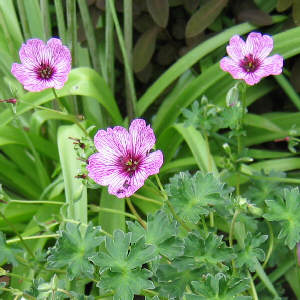
with: mauve creeping thyme, Viola labridorica, Saxifraga (white) & small version of Saxifraga 'London Pride'
near: Scabiosa columbaria 'Blue Butterfly' & 'Pink Mist'
Geranium endressii: pink Endres Cranesbill (Border Type)

where: front border position, walk edger, groundcover
with: purple, white and pink forms of Digitalis, Iris x germanica (blue)
Geranium endressii 'Wargrave Pink': warm salmon-pink
combined with: Salvia nemerosa 'Superba', Oenothera, Nepeta, Campanula, Phlox & Iris
combined with: Geranium pratense 'Mrs. Kendall Clark' & Geranium himalayense
Geranium sanguineum striatum: pale pink, deep rose veins, an Alpine type, 12"
formerly: Geranium sanguineum lancastriense
where: as a border edger
in front of: Hosta, Hemerocallis (dwarf daylily forms) & Bergenia
in front of: Paeonia (dark red), Iris sibirica (nearly any colour), both in front of Thalictrum aquilegiafolium
Geranium sanguineum 'Lancastriense': Alpine
synonym: Geranium striatum
with: white, blue or lavender bloomers
Geranium cinereum spp. subcaulescens 'Ballerina': 6" pink, maroon veins, darker centre
with: silver Artemisia including 'Silver Mound'
with: mauve creeping thyme, Viola labradorica, Saxifraga (white) & small version of Saxifraga 'London Pride'
combined with: Astrantia major, Iris sibirica 'Little White' & Heuchera 'Pluie de Feu' (cherry red)
near: Scabiosa columbaria 'Blue Butterfly' & 'Pink Mist'
Any of the links below will provide a wealth of ideas for planting partners for numerous forms of this wonderful plant.
Geranium Profile
blue perennial Geraniums
edging Geraniums
Geraniums for foliage effect
perennial Geraniums for shade
white perennial Geraniums
Simply Special Perennials - Hardy Geranium's many forms
GYPSOPHILA
Pink Baby's Breath? Certainly! There are pink choices in both the tall paniculata species as well as the low edging type below.
Gypsophila repens 'Rosea': Creeping Baby's Breath

over: Crocus
between: different Dianthus species
in front of: Iris x germanica (dark violet)
White Baby's Breath forms may be the best known. But there are other types as well. Follow the links below for partnership ideas and information.
Baby's Breath with silver foliage
white-flowered Baby's Breath
HELIANTHEMUM
Commonly called Sun Rose or Rock Rose, these short-statured creepers make wonderful additions at the front edge of a sunny bed where drainage is excellent. There is a wealth of colour choices including the pink form in the border around this page.
Helianthemum 'Wisley Pink': Sun Rose, single rose-like blooms over large, sprawling mounds of silvery foliage, 12"x18"
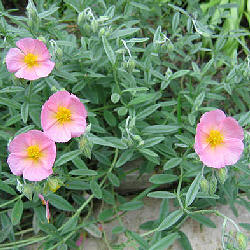
seen in the border around this page, as well as in the image at the top of the page and directly above
where: edger, rock gardens, over stone walls, in containers
with: Allium tuberosum, Sedum spectabile ‘Carmen’, Stachys byzantina
behind: Salvia officinalis ‘Purpurascens’
in front of: Linaria purpurea ‘Canon Went’
HEMEROCALLIS
 The companions chosen for a daylily can greatly affect the garden picture you wish to create. Experiment by removing a single flower and walk with it around your garden. Hold it against other co-blooming perennials to see what matches or what clashes. Find a colour echo perhaps in a co-blooming plant. If you want the flower itself to predominate, hold it against various out-of-bloom perennials to see what will serve as a wonderful foil to make it stand out either for its colour, shape or texture. Or try it next to a mounding foliage plant that will contrast with the strappiness of the daylily foliage. The possibilities are endless and you'll soon know where to move a particular daylily for best effect when it comes time to divide for propagation. Be sure to make notes for future reference.
Some of the daylilies below are Spider and Unusual Form Daylilies. Follow the link to learn more about the beautiful cultivars available in these two classes and see images that show their amazing appearance. You will also discover how to find suppliers of these classes in your area.
Hemerocallis 'Cherry Cheeks': raspberry-pink
The companions chosen for a daylily can greatly affect the garden picture you wish to create. Experiment by removing a single flower and walk with it around your garden. Hold it against other co-blooming perennials to see what matches or what clashes. Find a colour echo perhaps in a co-blooming plant. If you want the flower itself to predominate, hold it against various out-of-bloom perennials to see what will serve as a wonderful foil to make it stand out either for its colour, shape or texture. Or try it next to a mounding foliage plant that will contrast with the strappiness of the daylily foliage. The possibilities are endless and you'll soon know where to move a particular daylily for best effect when it comes time to divide for propagation. Be sure to make notes for future reference.
Some of the daylilies below are Spider and Unusual Form Daylilies. Follow the link to learn more about the beautiful cultivars available in these two classes and see images that show their amazing appearance. You will also discover how to find suppliers of these classes in your area.
Hemerocallis 'Cherry Cheeks': raspberry-pink
with: white Monarda 'Snow Queen'
Hemerocallis 'Cleopatra': pink melon with red-purple eyezone, scape height 34", bloom 5"

this Spider cultivar was registered in 1964, Spider Ratio 5.20:1, bloom season E
Hemerocallis 'Enjoy': Persian Lilac self with pale yellow throat, scape height 28", bloom 7", Reblooming & Fragrant
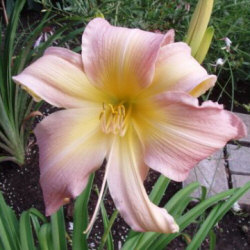
this Unusual Form Crispate cultivar was registered in 1974, MLa bloom season
Hemerocallis 'Lake Norman Spider': fragrant rose-pink blend, cream green eyezone & green throat, scape height 28", bloom 8"

in spite of its name, this is not a Spider daylily
this Unusual Form Crispate cultivar was registered in 1981, bloom season M
Hemerocallis 'Lullaby Baby': light pink with green throat, scape height 19", bloom 3.5", season EM

this is a fragrant daylily registered in 1975
Hemerocallis 'Pink Super Spider': rose and pink cream blend with cream green eyezone and green throat, season M

in spite of its name, this is not a Spider daylily
this Unusual Form Crispate cultivar was registered in 1982, height 32", bloom 10", Rebloom, Semi-Evergreen, Diploid
Daylily choices abound. The links below contain hundreds of ideas for appropriate companion plants along with useful and interesting information about the daylily itself.
numerous Daylilies in a variety of colours and shapes
orange Daylilies
purple Daylilies
red Daylilies
Spider and Unusual Form Daylilies
white Daylilies
yellow Daylilies
HEUCHERA
  There are Coral Bells in numerous colours today, in both flowers and foliage, including the pink forms below.
Heuchera: pink or red
Heuchera: pink-flowered
Heuchera 'Canyon Pink': dwarf hot pink
Heuchera 'Strawberry Swirl': ice-pink flowers, ruffled foliage, 28" x 24"
The links below will take you to only a fraction of the forms of Coral Bells that are available today from many plant nurseries. Learn more about this perennial from the information also provided on each page.
There are Coral Bells in numerous colours today, in both flowers and foliage, including the pink forms below.
Heuchera: pink or red
Heuchera: pink-flowered
Heuchera 'Canyon Pink': dwarf hot pink
Heuchera 'Strawberry Swirl': ice-pink flowers, ruffled foliage, 28" x 24"
The links below will take you to only a fraction of the forms of Coral Bells that are available today from many plant nurseries. Learn more about this perennial from the information also provided on each page.
edging Coral Bells
Coral Bells to attract Hummingbirds
purple Coral Bells
red Coral Bells
silver foliage Coral Bells
variegated foliage Coral Bells
white Coral Bells
x HEUCHERELLA
The best of the foliage of the Tiarella genus crossed with the best of the flowers of the Heuchera genus produced the beautiful Foamy Bells. Perfect for full sun to woodland shade conditions, it does best in rich and moist but well-drained soil.
x Heucherella alba 'Bridget Bloom': Foamy Bells, shell pink (a light pink)
Don't be afraid to try something new. If you don't have any of these yet, follow the link below for ideas of which ones will add charm to your shady garden areas.
shade-loving Foamy Bells
Foamy Bells with variegated foliage
HYACINTHUS
Fragrant and floriferous, the wonderful Hyacinth should be in every garden. More pricey thn many other spring-blooming bulbs, it is well worth the extra cost. By choosing early, mid-season and late-blooming types you can ensure prolonged enjoyment of both single and double-flowered forms. Plant in fall in full to part sun, 5" deep and 2" apart.
Hyacinthus: pink & blue forms
with: Narcissus (yellow & cream-coloured), Iberis sempervirens
Hyacinthus 'Hollyhock': compact, deep pink
with: Anemone blanda 'White Splendor'
Have a look at many more wonderful Hyacinth cultivars by following the link below.
various Hyacinths
KOLKWITZIA
The common name says it all - Beauty Bush. If you want to make your neighbours and passers-by take notice, plant this wonderful deciduous arching shrub to your property. In full sun and fertile, well-drained soil, it will grow to its potential 10' by 10' size. In late spring to early summer you can enjoy its bell-shaped pinkish flowers with yellow centers.
Kolkwitzia amabilis: Beauty Bush
with: annual sweet peas, autumn-flowering Clematis (to grow through)
echo behind: Paeonia (same pink as throat of shrub)
underplant with: Erythronium, Scilla, Chionodoxa
LAMIUM
A nearly perfect groundcover for shade, Dead Nettle has foliage in various shades of green with and without silver markings in a variety of patterns. Spring-blooming flowers are numerous. There is even sporadic bloom until late in the fall. Shear plants after bloom for compactness.
Lamium maculatum 'Beacon Silver': pink form of 'White Nancy'
Lamium maculatum 'Shell Pink': soft pink flowers, to 6" tall
Try any of the infinite variety of forms available.
Dead Nettle for shade
Dead Nettle with silver foliage
white Dead Nettle
Dead Nettle with variegated foliage
LAVATERA
If you like Hollyhocks or Rose-of-Sharon to which it is similar, you will certainly welcome this beauty to your gardens. Constant bloom and sparkling colour are highlights of this warm-weather or tender annual.
Lavatera: pink
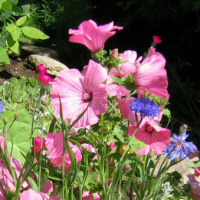
lovely in the image above with a blue cornflower
Lavatera 'Rosea': pink
with: blue New England or New York Asters and Aster x frikartii (also blue)
LILIUM
Lilies are avilable in a seemingly unlimited variety of types, heights, shapes, colours and bloom times. Late fall is the time to propagate by division.
Lilium:

the unidentified cultivar above is a Pepto-Bismol pink colour that adds a wonderful accent to the garden
Lilium 'Montreux': dusky rose Hybrid Asiatic Lily
with: every colour imaginable
with: Lilium 'Apollo'
Lilium 'Trance': Oriental Lily, pink with a trace of blue
with: Perovskia atriplicifolia
Any of the ideas at the following links will help you find the perfect partners for your Lilies and grow them well.
orange Lilies
red Lilies
white Lilies
yellow Lilies
FOR MORE PINK PERENNIALS & THEIR COMPANIONS, FOLLOW THE LINK BELOW.
All of our own Gardens By The Bay pages can be accessed by clicking on the links below.
HOME
GARDEN POETRY |
GARDEN POETRY MUSE
GEORGIAN BAY VIEW
BOTANICAL LATIN - BASICS
COLOR THEORY
THE GARDENS
CORNER GARDEN CONSTRUCTION |
CORNER GARDEN PLANTING |
LONG GARDEN
EAST GARDEN |
HOSTA GARDEN |
NORTH GARDEN |
WINTER GARDENS
PLANT PARTNERSHIPS
BLUE PERENNIALS Aconitum -
Geranium |
Iris - Vinca
BULBS Allium - Hyacinthus |
Narcissus only |
Tulipa only |
Minor Bulbs
BUTTERFLY MAGNETS Anaphalis - Hemerocallis |
Liatris - Veronicastrum
 DAYLILIES Spider & Unusual Form DAYLILIES Spider & Unusual Form EDGERS Arabis - Iris |
Nepeta - Veronica
FOLIAGE PERENNIALS
Alchemilla - Tanacetum
HOSTA Hosta - all
HUMMINGBIRD-FRIENDLY PERENNIALS Alcea - Salvia
ORANGE PERENNIALS Achillea - Tulipa
ORNAMENTAL GRASSES Acorus - Imperata |
Miscanthus - Spodiopogon
PINK PERENNIALS Achillea - Lilium |
Lychnis - Veronica
PURPLE PERENNIALS Aconitum - Liatris |
Polemonium - Veronica
RED PERENNIALS Achillea - Veronica
SHADE PERENNIALS Aegopodium - Erythronium |
Ferns - Polemonium |
Polygonatum - Vinca
SILVER FOLIAGE PERENNIALS
Achillea - Cerastium
|
Cornus - Limonium
|
Lunaria - Veronica
SIMPLY SPECIAL PERENNIALS Acanthus - Saxifraga
WHITE PERENNIALS Achillea - Iris |
Kalimeris - Yucca
YELLOW PERENNIALS Achillea - Hypericum |
Inula - Verbascum
VARIEGATED-FOLIAGE PERENNIALS Acorus - Erythronium |
Hakonechloa - Lysimachia |
Miscanthus - Yucca
PLANT PROFILES
Dianthus 'Tiny Rubies' |
Geranium |
Geum coccineum |
Kerria japonica |
Knautia macedonica
Paeonia tenuifolia |
Papaver somniferum |
Rudbeckia |
Salvia 'East Friesland'
Trollius |
Veronica 'Sunny Border Blue'
PROPAGATION
DIVISION - SPRING ONLY |
DIVISION - FALL ONLY |
DIVISION - SPRING OR FALL |
DO NOT DIVIDE
FERTILIZATION
EDGERS Arabis - Iris |
Nepeta - Veronica
FOLIAGE PERENNIALS
Alchemilla - Tanacetum
HOSTA Hosta - all
HUMMINGBIRD-FRIENDLY PERENNIALS Alcea - Salvia
ORANGE PERENNIALS Achillea - Tulipa
ORNAMENTAL GRASSES Acorus - Imperata |
Miscanthus - Spodiopogon
PINK PERENNIALS Achillea - Lilium |
Lychnis - Veronica
PURPLE PERENNIALS Aconitum - Liatris |
Polemonium - Veronica
RED PERENNIALS Achillea - Veronica
SHADE PERENNIALS Aegopodium - Erythronium |
Ferns - Polemonium |
Polygonatum - Vinca
SILVER FOLIAGE PERENNIALS
Achillea - Cerastium
|
Cornus - Limonium
|
Lunaria - Veronica
SIMPLY SPECIAL PERENNIALS Acanthus - Saxifraga
WHITE PERENNIALS Achillea - Iris |
Kalimeris - Yucca
YELLOW PERENNIALS Achillea - Hypericum |
Inula - Verbascum
VARIEGATED-FOLIAGE PERENNIALS Acorus - Erythronium |
Hakonechloa - Lysimachia |
Miscanthus - Yucca
PLANT PROFILES
Dianthus 'Tiny Rubies' |
Geranium |
Geum coccineum |
Kerria japonica |
Knautia macedonica
Paeonia tenuifolia |
Papaver somniferum |
Rudbeckia |
Salvia 'East Friesland'
Trollius |
Veronica 'Sunny Border Blue'
PROPAGATION
DIVISION - SPRING ONLY |
DIVISION - FALL ONLY |
DIVISION - SPRING OR FALL |
DO NOT DIVIDE
FERTILIZATION
BULBS |
ORNAMENTAL GRASSES |
PERENNIALS |
SHRUBS |
VINES
LINKS
GARDENS |
LOCAL GARDENS |
BOTANICAL TERMINOLOGY
GARDENING BOOKS |
NON-GARDENING
HOME
|
|
|